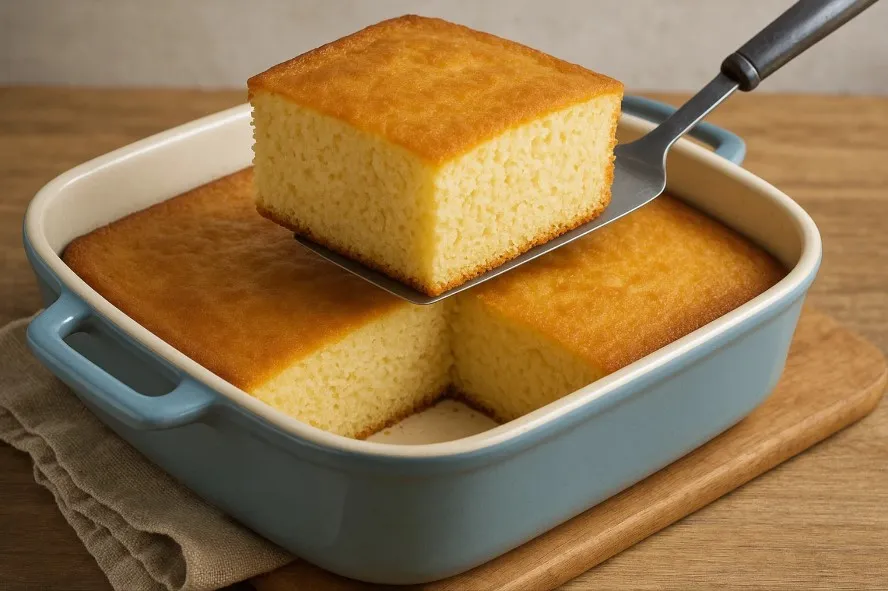Absolutely! A casserole dish can double as a cake pan in a pinch—just grease it thoroughly (butter + flour or non-stick spray) and adjust baking time (glass dishes retain heat longer, so reduce oven temp by 25°F to prevent over-browning). For easy removal, line the dish with parchment paper or serve slices directly from the dish. Works best for dense cakes (like pound cake) or sheet-style cakes!
Last month, in a fit of culinary mischief, I decided to bake my birthday cake in a casserole dish after discovering my only cake pan was hosting an unfortunate science experiment in the back of my fridge.
Spoiler: it was an adventure involving uneven edges, some creative frosting, and the kind of kitchen chaos that the Great British Bake Off would never air. But hey, necessity is the mother of invention—and, sometimes, cake disasters. Let’s explore “Can You Bake a Cake in a Casserole Dish?”

Casserole Dish vs. Cake Pan: The Crucial Differences (And Why I Learned the Hard Way)
When it comes to baking cakes, I always thought a pan was a pan—until the day I tried using a casserole dish as a cake pan alternative. If you’re wondering whether you can swap a cake pan for a casserole dish, you’re not alone. I learned the hard way that the differences between these two types of bakeware can make or break your cake.

The first thing I noticed is the shape and depth. Most casserole dishes are deeper (usually 2-3 inches) and are often made of glass or ceramic. In contrast, a typical cake pan is shallower (about 1-2 inches) and made of metal. This difference might seem minor, but it changes everything about how your cake bakes.
Metal cake pans heat up and cool down quickly. This gives cakes that classic, light crumb texture we all expect. But glass and ceramic—like those used in casserole dishes—hold onto heat much longer. That means the edges of your cake can overbake while the center is still catching up. In my own kitchen experiment, my cake baked in a casserole dish took a full 10 minutes longer than usual. Not only that, but it didn’t rise as high as it does in a regular cake pan. The center was denser, and the edges were a bit too crispy for my liking.
Here’s a quick look at the differences I found:
| Bakeware | Depth | Material | Baking Time (my test) |
|---|---|---|---|
| Casserole Dish | 2-3 inches | Glass/Ceramic | +10 minutes |
| Cake Pan | 1-2 inches | Metal | Standard |
Research shows that baking cakes in deep pans or casserole dishes may require adjustments to both baking time and baking temperature. Choosing the right bakeware is more important than I realized—especially if you want that perfect rise and crumb. As Mary Berry wisely said:
‘Matching your bakeware to your recipe can mean the difference between a perfect sponge and a soggy bottom.’ – Mary Berry
So, can you use a casserole dish for baking cakes? Yes, but expect changes in texture and timing due to the dish’s depth and material. If you’re experimenting with cake pan alternatives, keep a close eye on your cake and be ready to adjust your expectations—and your timer.
Essential Cake Baking Tips for Casserole Conversions

If you’ve ever wondered whether you can bake a cake in a casserole dish, you’re not alone—I’ve run my own kitchen experiments, and let me tell you, it’s absolutely possible. But, as with all cake baking tips, success starts long before you pour in the batter. The real secret? It’s all about preparing cake pans (or in this case, casserole dishes) the right way.
First things first: grease and flour your casserole dish thoroughly. I can’t count the number of times I’ve had to battle a stubborn cake with a spatula, only to end up with a crumbly mess. Especially with ceramic or glass, the grease and flour method is king for nonstick results. As Sally McKenney wisely says:
“The best cakes start before the oven – pan prep is everything.”
Another critical step is cake batter filling. Most recipes tell you to fill cake pans about ½ to ⅔ full. The same rule applies to casserole dishes—ignore it, and you risk a cake disaster (overflow is no joke). Research shows that filling pans correctly helps avoid disasters and ensures even baking. Deep casserole dishes can also affect how your cake rises. Expect a denser crumb and less of that classic domed top.
Now, let’s talk temperature. Casserole dishes, especially glass or ceramic, hold heat differently than metal pans. I always lower the oven temperature by 25°F compared to the recipe and extend the baking time. This keeps the edges from overbaking before the center is set. And don’t just check for doneness at the edges—poke the center with a toothpick or skewer. The depth and material of the dish can trick you into thinking the cake is done before it really is.
Here’s a quick reference table for these essential adjustments:
| Tip | Adjustment |
|---|---|
| Oven Temperature | Lower by 25°F from recipe direction |
| Pan Filling | Fill casserole/cake pan 1/2 to 2/3 full |
In my kitchen, preparing cake pans properly—whether it’s a classic round tin or a trusty casserole dish—has saved me from more than one cake disaster. These simple cake baking tips make all the difference when you’re swapping pans for casseroles.
Adapt or Improvise: When Substituting Bakeware (Plus, My Accidental Upside-Down Cake Saga)
If you’ve ever found yourself halfway through a cake recipe only to realize you don’t own the “right” pan, you’re not alone. I’ve been there—staring at my trusty casserole dish and wondering if it could stand in for a classic cake pan. The answer? With a little flexibility, yes, but there are some important things to keep in mind when considering cake pan alternatives.
First, it’s helpful to remember that cake recipes usually specify a particular pan size and shape for a reason. The pan affects everything from baking time to the final texture and height of your cake. For example, a standard 8-inch round cake pan holds about 6 cups of batter, while a 7×11-inch casserole dish can hold up to 8 cups. That extra volume can change how your cake bakes—sometimes in surprising ways.

When swapping pans, I try to follow the spirit of the recipe, not just the letter. If the recipe calls for a cake round, a casserole dish can work in a pinch, but you’ll need to adjust your expectations for height and shape. The cake might come out a bit flatter or take longer to bake through. It’s a bit like wearing hiking boots to a ballroom dance—not technically wrong, just a little unconventional!
One of my most memorable kitchen experiments happened when I attempted to bake a vanilla sponge in a casserole dish. I lined it with a makeshift cake pan liner, thinking I was prepared. But when I tried to invert the cake onto a plate, half of it clung stubbornly to the dish. The result? A “deconstructed upside-down cake” that my family affectionately dubbed “Franken-cake.”
That experience taught me that no two swaps are ever quite the same. Cake pan alternatives require a bit of caution and a willingness to improvise. You may need to adjust baking times, use extra cake pan liner, or even rethink your cake assembly if things don’t go as planned. As Duff Goldman wisely said:
“Great bakers aren’t afraid to improvise.”
Research shows that preparing your pan properly—whether it’s a classic cake pan or a casserole dish—makes a big difference. Greasing, flouring, or using a liner can help prevent sticking, but results may still vary. Ultimately, cake recipes are a guide, not a rulebook, and sometimes the best creations come from a little kitchen improvisation.
When Necessity Bakes the Cake
If you’ve ever found yourself halfway through a recipe only to realize your trusty cake pan is missing, you’re not alone. That’s exactly where my kitchen adventure with baking cakes in a casserole dish began. It’s one of those moments where necessity really does bake the cake—sometimes quite literally! And let me tell you, with a few smart tweaks and a willingness to experiment, baking cakes in a casserole dish is not only possible, it can be surprisingly rewarding.
Research shows that the key to successful cake baking, no matter what pan you use, comes down to preparation and precision. Properly preparing your casserole dish—greasing, flouring, or lining it—helps prevent sticking and ensures your cake releases easily. Filling the dish to the right level (usually about halfway or two-thirds full) is also crucial. Overfilling can lead to batter overflow, while underfilling might leave you with a flat, dry cake. And of course, following the recipe’s instructions for temperature and bake time is essential, especially since casserole dishes can be deeper or differently shaped than standard cake pans. You may need to adjust the baking time or lower the oven temperature slightly to ensure even cooking.
It’s true, the texture and shape of your cake might not be identical to one baked in a classic round or square pan. But that’s not always a bad thing. Sometimes, the best baking stories—and flavors—come from these kitchen curveballs. I’ve discovered that a casserole dish can produce a cake with a unique crumb and a rustic charm that’s hard to replicate. Plus, experimenting with different pans can lead to new favorite recipes and textures you might never have tried otherwise.
As Julia Child famously said,
‘Some of the best recipes are born from happy accidents.’
That’s certainly been my experience. So, if you find yourself without a cake pan, don’t hesitate to reach for that casserole dish. With the right baking tips and a bit of creativity, delicious results are well within reach. After all, baking cakes is as much about the joy of discovery as it is about following the rules. Happy baking!
Frequently Asked Questions
Can I bake a cake in a metal casserole dish?
Yes, but metal heats faster than glass, so watch baking time closely.
Why did my cake burn on the sides in a casserole dish?
Glass and ceramic retain heat longer. Try lowering the oven temperature.
Can I use a disposable aluminum casserole pan for cakes?
Absolutely! Just support it with a baking sheet for stability.
Do I need to adjust the recipe for a deeper dish?
Yes, a deeper dish may require extra baking time. Use a toothpick to test doneness.
“The kitchen is where creativity meets necessity. Sometimes the best bakes come from improvisation.” – Ina Garten
When to Stick with a Traditional Cake Pan
While casserole dishes can work, some cakes are better suited for standard pans:
- Layer cakes – Need even, shallow layers for stacking.
- Angel food or sponge cakes – Require a tube pan for proper rising.
- Delicate desserts – Like soufflés or flourless cakes.
Conclusion
So, can you use a casserole dish for baking cakes? Yes! With the right adjustments, a casserole dish can be a handy alternative. Stick to dense cakes, grease the dish well, and keep an eye on baking time.
But for light, airy cakes, a traditional cake pan is still the best choice. Whether you’re improvising or experimenting, baking should be fun—so don’t be afraid to try new things!
“Good baking is about understanding your tools and adapting. A casserole dish is just another tool in a baker’s kit.” – Mary Berry
Now, grab your dish and get baking!

